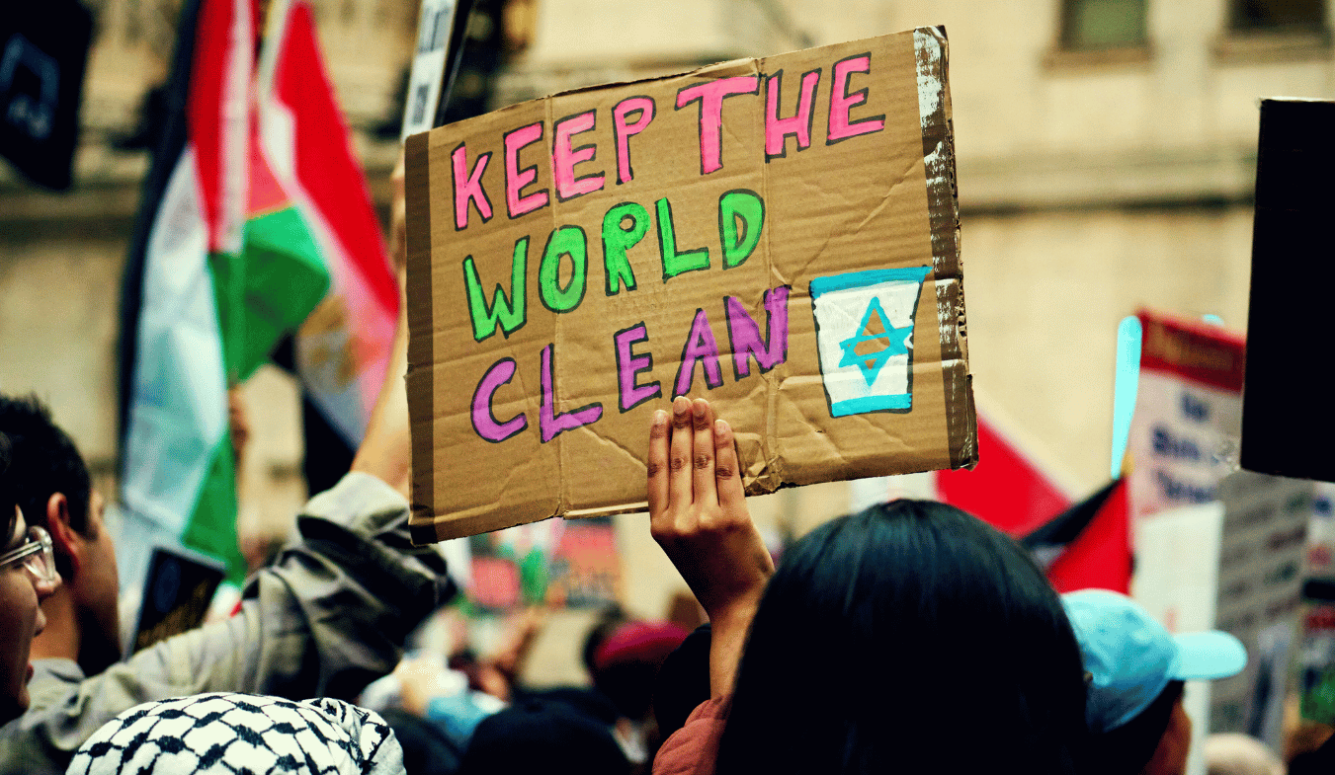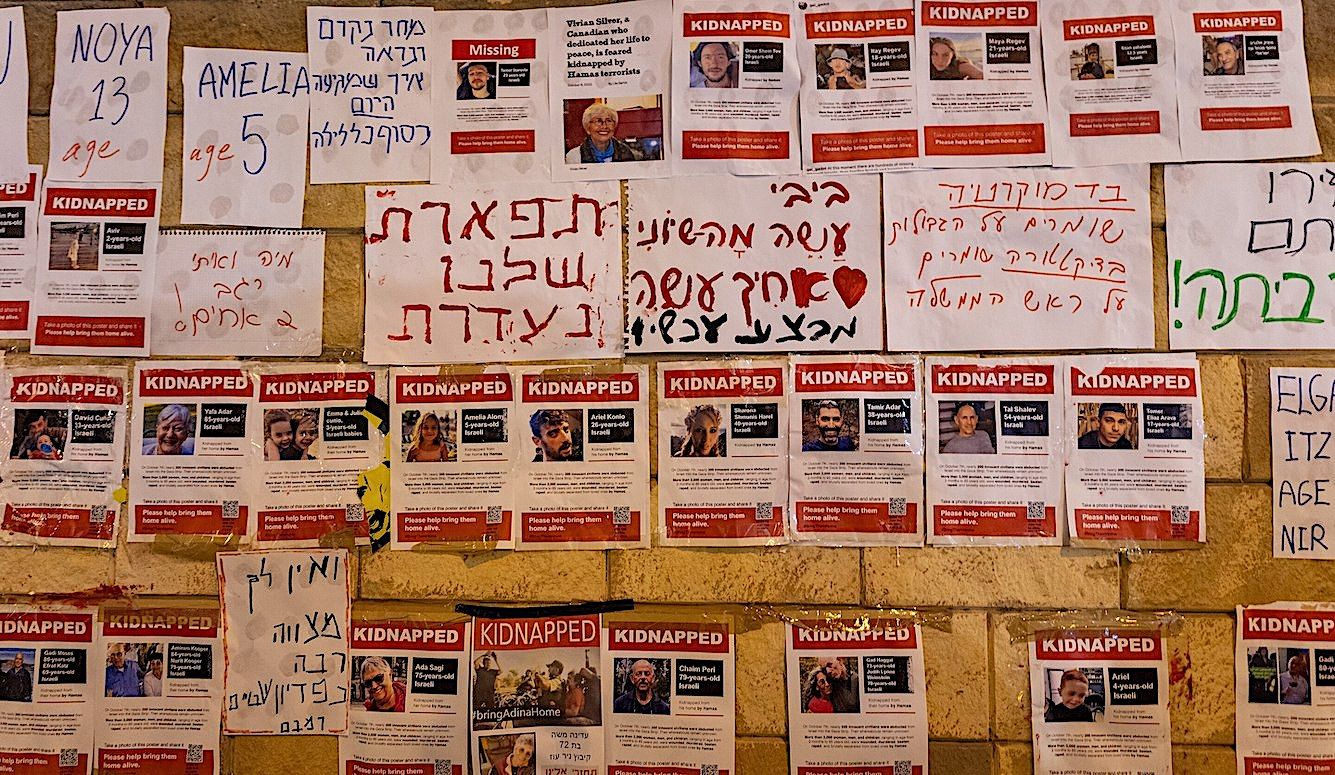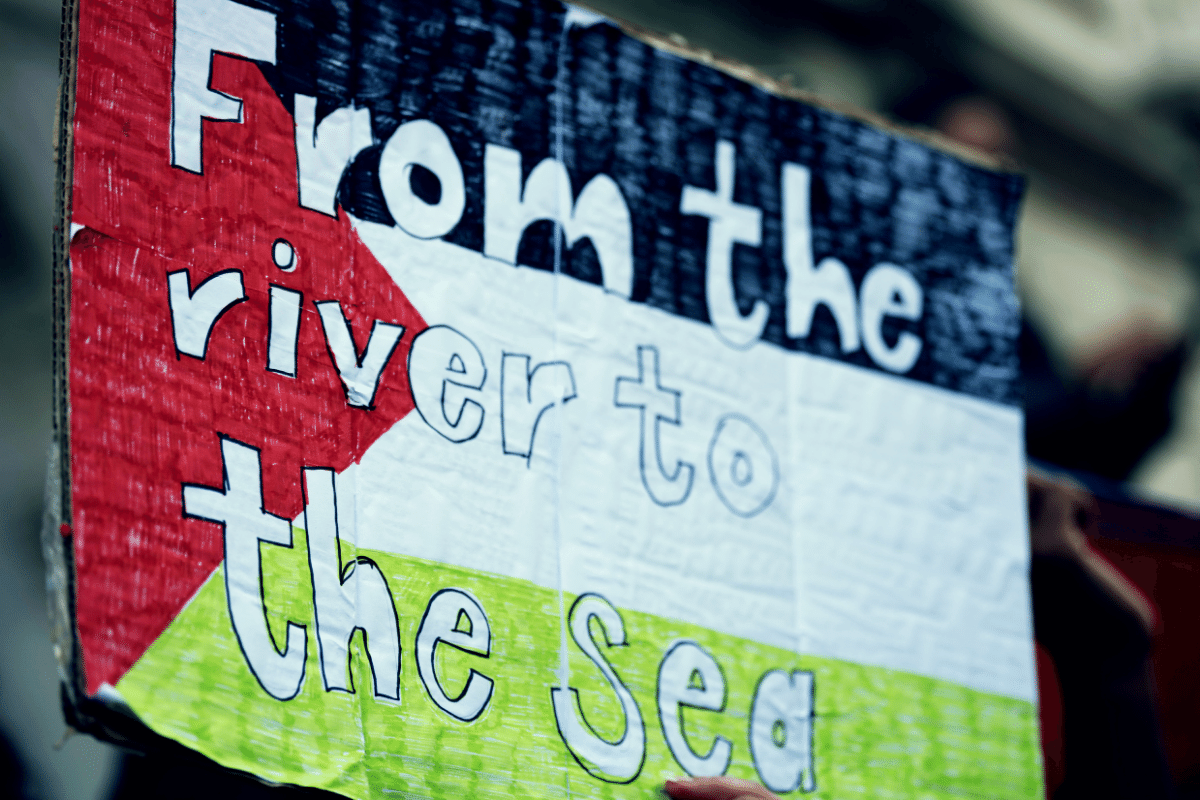Israel
Muslim Antisemitism and the Western Left
The pro-Hamas demonstrations are driven by the identification of Israel with “colonialism” and the idea that the Palestinians are anti-colonialists. This approach is based on ignorance.

The Hamas attack on a dozen or so Israeli villages and towns on 7 October produced truly horrific images—of decapitated babies, raped and murdered women, mutilated corpses, slaughtered families, and 230 infants, children, women, men, and octogenarians taken as hostages to dungeons in Gaza.
But no image was as disheartening as the photo of Greta Thunberg, the young Swedish environmental activist, holding a sign reading “Stand with Gaza” in a photo taken mere days after the killing of around 1,400 people, mostly Jews, along with a smattering of Israeli Arabs and East Asian agricultural workers, by the Palestinian fundamentalists. “Stand with Gaza” appeared with no qualifiers. Given the circumstances, it meant “we oppose the Israeli counterstrike against the terrorists in Gaza.” And perhaps it also meant that Israel had no right to exist, and that Hamas are right.
Week 270. Today we strike in solidarity with Palestine and Gaza. The world needs to speak up and call for an immediate ceasefire, justice and freedom for Palestinians and all civilians affected.#FreePalestine #IStandWithPalestine #StandWithGaza #FridaysForFuture
— Greta Thunberg (@GretaThunberg) October 20, 2023
Thread🧵 pic.twitter.com/0hVtya0yWO
Thunberg was not alone. Across the campuses of Western Europe and America’s leading universities, youngsters demonstrated and marched in support of the Palestinians. The slaughter of the Jews that triggered the Israeli assault on Hamas was never mentioned. Prominent among the demonstrators, to judge from the photos, were Muslims (as indicated by their headwear and scarves), but there was also, often, a substantial non-Muslim presence consisting of Christians and at least a sprinkling of Jews.
Thunberg’s stance was echoed in an “open letter” of 19 October, published by Artforum, a leading American art magazine. It was signed by 8,000 artists, art critics, book editors, and gallery owners. The letter absurdly condemns the Israeli assault on Gaza as “a genocide”—and fails to mention the 7 October Hamas attack. It ends by calling for an international boycott of Israel’s universities—which, incidentally, are hotbeds of opposition to the Israeli occupation of the Palestinian territories and maltreatment of the Palestinians. (The magazine’s editor, David Velasco, was subsequently fired by the publication’s owners.) This Artforum letter echoes, almost word for word, the open letter “to International Academic Institutions” published four days earlier by Birzeit University, the leading Palestinian institution of higher education in the West Bank. That letter, which also ignores the massacre of 7 October, condemns Israel’s “genocidal war on the Palestinian people.”
Among the Artforum letter’s signatories was Judith Butler, a philosopher and gender studies professor from the University of California, Berkeley, who back in 2006 declared: “Understanding Hamas [and] Hezbollah [the sister Iranian-backed fundamentalist Shi’ite militia/terrorist organization that controls Lebanon] as social movements that are progressive, that are on the Left, that are part of the global Left, is extremely important.”
At the end of the nineteenth century, what the “global Left” consisted of was fairly clear. But today? Does Putin, whose invasion of Ukraine is backed by Iranian drones, belong among the Left? Or totalitarian China, with its repression of the Uyghurs and suppression of freedom in Hong Kong? Who knows where Butler and her ilk stand on these questions.
But to call Hamas “progressive” and “Left” is about as ignorant and wrong-headed as one can get. Hamas is proudly theocratic, anti-democratic, anti-socialist, misogynistic, homophobic, and antisemitic. The terrorist group seeks to resurrect the values and goals of seventh-century Islam, and to impose them across the Middle East and—Allah willing—eventually across the globe.
I have closely followed the trajectory of Hamas, the Palestine branch of the Egyptian Muslim Brotherhood, since it emerged in Gaza in the late 1980s, in particular in my 2009 book One State, Two States: Resolving the Israel/Palestine Conflict. The best and most succinct entry point for understanding Hamas is the movement’s foundational “Charter” or “Covenant” (readily available online, in English).
It defines “the Jews” as “smitten with vileness, wheresoever they are found.” The Jews, states the Charter, “with their money, stirred revolutions in various parts of the world… They were behind the French Revolution, the Communist Revolution… they were behind World War I… [and] World War II, through which they made huge financial gains.”
So, how does Hamas intend to solve “the Jewish problem”? The Charter states: “The Prophet… has said: ‘The time [the Day of Judgment] will not come until Muslims fight the Jews and kill them, when the Jew will hide behind stones and trees. [And] the stones and trees will say O Muslims, O Abdullah, there is a Jew behind me, come and kill him.’” We saw this happen, almost literally, on 7 October.

As to its immediate political goal, the Charter is clear: Hamas seeks to turn the land between the Jordan River and the Mediterranean Sea—“from the river to the sea,” a phrase echoed in many of the post-7 October demonstrations—that is, all the territory of British Mandate Palestine or the historical Land of Israel into a Sharia-governed Islamic polity. It intends “to raise the banner of Allah over every inch of Palestine,” after obliterating the Jewish state “through jihad,” as “Islam obliterated others before it.”
Thunberg and Butler and their colleagues, feminists all, might also ponder the Charter’s designated role for women:
The Muslim woman… is the maker [i.e., birther] of men… Woman… plays the most important role in looking after the family, rearing the children and imbuing them with moral values and thoughts derived from Islam… She has to be of sufficient knowledge and understanding where the performance of housekeeping matters are concerned, because economy and avoidance of waste of the family budget, is one of the requirements.
Hamas’s—that is, the Muslim Brotherhood’s—ultimate goal reaches well beyond the Middle East. As the Charter, with calculated vagueness, poetically puts it, it extends “everywhere across the globe… to the depth of the earth and… out to heaven… The movement is a universal one.” Europeans and Americans should take note.
The Charter has never been rescinded, revised, or updated—not by a single word.
What has brought together the hundreds of thousands of pro-Hamas demonstrators in the West in the past weeks? Most of the Muslim participants were no doubt driven by the gut instinct of identification with the Palestinians as fellow members of the Muslim ummah (nation) who are being victimized. “Regardless of the rights or wrongs of the issue or of cause and effect,” they might say, “we are with you, our brothers in Allah.”
But this global Muslim gut instinct is selective. One rarely sees Muslims in Paris, Brussels, or Berlin or at Berkeley or Harvard demonstrate when Sudanese Muslims are murdering tens of thousands of fellow Muslims in Darfur; or when the Assad regime is using poison gas to murder hundreds of thousands of brother Muslims in Syria; or when the ayatollahs in Tehran are murdering, torturing, and raping thousands of Muslims across Iran.
Indeed, this brotherly instinct only comes into play—and brings them out into the streets—when “whites” kill Muslims and especially when it is “the Jews.”
Which brings us to the antisemitism embedded deep in the psyche of Islam—and not just in that of Hamas. That antisemitism is historically rooted in the non-acceptance of Mohammed and his new religion by the Jewish tribes of Hijaz in the seventh century and in how that episode is treated in the Quran, where the Jews are defined as a “base people,” “killers of prophets,” and “sons of apes and pigs” (the theme of Jewish “apedom” appears in the Quran three times). Hence, the Jews are reviled throughout the Islamic world as “enemies of Islam.” Hence, the worldwide surge in antisemitism this past month, the largest since the Holocaust. Hence, the frankly antisemitic signs held aloft—usually by Muslims—showing Stars of David alongside Nazi swastikas, and the chants such as “kill the Jews” and “kill Israel”; hence the spate of fire-bombings of synagogues and desecration of Jewish cemeteries across Europe; hence the attempt by a mob in Dagestan, in southern Russia, to lynch passengers getting off a flight from Tel Aviv.
This Muslim antisemitism has coalesced with traditional Christian antisemitism, which originated back in the first century, with the Jews’ rejection of Jesus and their alleged role in his death and the way in which these events are portrayed in the Gospels.
The curious thing is that antisemitic incidents increased exponentially after the massive Hamas slaughter of 7 October, even before the Israelis launched their counterattack on Gaza. In other words, it is signs of Jewish—meaning Israeli—weakness that initially triggered the recent antisemitism in the United States, rather than perceived Israeli wrongdoing against Arabs, though that surely didn’t help. In this, there are echoes of 1930s Poland, where antisemitism increased in response to German attacks on Jews and signs of Jewish weakness. Jewish students on Western campuses are often harassed by both Muslim and “liberal” fellow students and testify to threats, intimidation, and real fear. The administrations of leading American universities, including Harvard, have avoided condemning the 7 October assault and have permitted anti-Zionist and antisemitic demonstrations on campus, under the guise of free speech. Jews in various European capitals have spoken of harassment on the streets and of the need to remove any signs of Jewishness (such as skullcaps). Israel’s National Security Council recently warned Israelis to simply avoid travelling abroad, to any destination.

Both the Muslim and non-Muslim participants in the pro-Hamas demonstrations, as well as the signatories to the anti-Israeli petitions, are driven by the identification of Israel with “colonialism” and the idea that the Palestinians are anti-colonialists. This approach is based on a great deal of ignorance. Zionism was a national liberation movement that sought to achieve sovereignty for the Jews in a small part of the Middle East, which had been the homeland of the Jews centuries before Muslim Arabs emerged from Arabia and conquered and settled Palestine and the rest of the Middle East, which had, until then, been inhabited by Christians, pagans, and Jews. The Jews who turned to Zionism in the late nineteenth and twentieth centuries were driven toward Palestine by the persecution they faced in the Russian Empire and in the Muslim Arab lands. They were not the agents of any imperial or colonial power—even though, from 1917 to 1937, they were briefly supported in immigrating to and settling in Palestine by the British Empire, which subsequently turned against them and supported the Arabs. Following the Six Day War of 1967, Israel “colonized” the West Bank and Gaza Strip with Jewish settlements, and to this extent it acted as a “colonialist” power—though Zionism, in essence, was, and remains, a nationalist, not a colonialist phenomenon. But in 2005, Israel uprooted its settlements in Gaza and withdrew its troops from the Strip. History is complicated.
Youngsters in the West—including many university lecturers, especially in cultural studies, literature, and gender studies—are profoundly ignorant of history and of the ins-and-outs of the Arab–Zionist conflict and think in—or at least brandish—simplistic slogans that depict history and reality in strictly black-and-white terms. In his 1978 essay collection, Under This Blazing Light, Israeli novelist Amos Oz put it this way:
There is a tendency to view the (political) world through a primitive catechism by which the forces-of-good face off against the forces-of-evil, whereby the forces-of-good are always and automatically identified with the exploited and oppressed “Third World” and the forces-of-evil are the “whites,” wherever they be. This reeks of an “inverted” racism, which regards different conflicts through the prism of the skin color of the sides involved.
At base, this outlook, according to Oz—who was extremely critical of Israel’s settlement enterprise in the Palestinian-inhabited territories—is underpinned by guilt, stemming from the centuries during which the allegedly decadent Western powers exploited and oppressed virile Third World populations. Oz was writing fifty years ago, but he could have been speaking of the demonstrating youngsters of Berkeley and NYU and describing how they see the current Hamas–Israel battle—regardless of how each side has in fact behaved.
As the Hamas onslaught on Israel’s southern villages recedes into the past and the IDF pounds Gaza and pushes into Hamas’s bastions, with the collateral damage and casualties that this necessarily involves, Muslim anger and “liberal” Western disapproval of Israel—the only semi-liberal, democratic country in a region typified by brutal autocracies and theocracies—are bound to increase.






